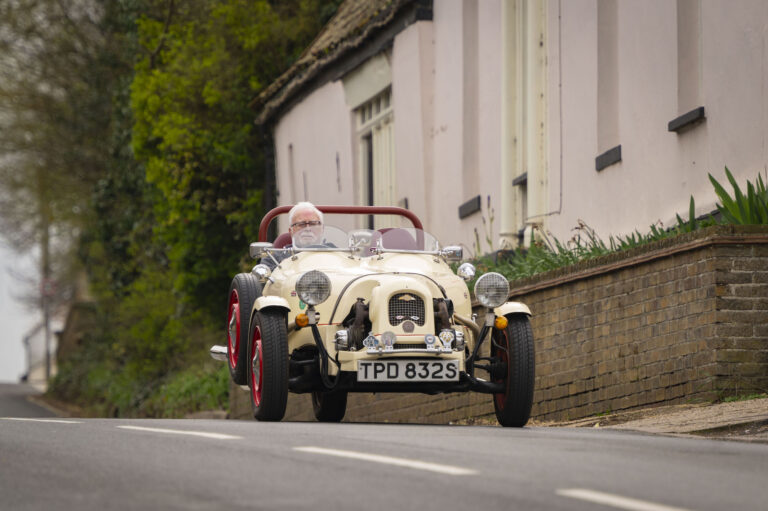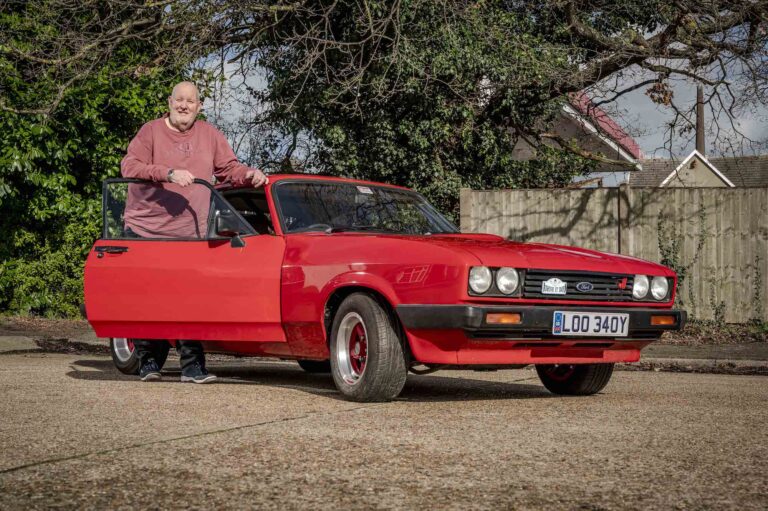Fangio, Moss, and Maserati left a lasting impression on a young Michael Roberts.
“I was always prejudiced in favour of Maserati from an early age, because they won some amazing races,” he says, recalling his 1950s childhood.
Fast forward a few decades, and he is chairman of the Maserati Club UK, and the proud owner of the concours-winning 1972 Maserati Indy you see here.
We’re chatting in the grounds of Michael’s 40-acre vineyard and woodland on the Essex-Suffolk border, which is home to the Indy – one of only 20 or so on the road in the UK.
It’s a beautiful car from every angle, a Grand Tourer that can seat four adults and a decent amount of luggage in its generous hatchback boot.
Michael, 75, a former banker and property developer, bought the Indy for £15,000 in 1992 after experiencing a steep learning curve with a Maserati Merak, and has since covered nearly 80,000 miles in the car all over Europe.
“It’s a joy to look at, so pleasant to drive, and the seats are so incredibly comfortable,” he says. “And it’s such a forgiving car. You can drive it in bad traffic through London and the plugs don’t oil up, or on a fast road for hours at a time quite happily.






“The 4.7-litre engine – a derivative of the racing engine – is a really solid, reliable motor.”
With 32 years of memories bound up in the car, anyone looking to buy it will always be given an apologetic smile and a shake of the head.
“As far as I’m concerned, I was thinking of being buried with it,” he laughs. “If the vikings are buried with their chariots, horses and longboats, maybe I should be buried in the car. It’s an East Anglia thing!
“But the sensible answer is, I’m sure it will end up with a descendant – my children have often mentioned how much they appreciate thrift, especially in an ancestor.”
His son, also Michael, is “sensitive to the fact of the design elegance, the brilliant engineering, and the investment that’s been made in it”.
Michael (senior) has spent a lifetime messing about with cars, from the E-Series Morris Eight he and some friends found abandoned near their home in Cheshire on the edge of the Pennines.
“I always like to tell people my first car was an E-Type,” he smiles. “It had been left unlocked and was in a fairly chronic state.
“There was a little gang of three of us who played cricket in the street nearby, so eventually we commandeered it.
READ MORE ABOUT SOME OF OUR GREATEST CLASSIC CARS WITH

A series of articles on our Cult Classics site.
“Because we were illegal and underage and all the rest of it, we decided to go into the hills on the basis it would be quieter there and we would be less obvious.
“However, of course this old abandoned car boiled over on a narrow very steep hill and we couldn’t decide how to turn it round. By the time we’d fiddled around, it had cooled enough to just about get to the top. But the brakes on the way down were less than satisfactory. Eventually I abandoned it outside another friend’s house.”
Michael then bought an Austin 7 van for £7 “with the express purpose of taking it apart to the last nut and bolt to have a look about how cars work”.
Then came a “wonderful Triumph Herald that never let me down, even though as I later found, not all the chassis was attached to the rest of the chassis”.
He then bought an MGA that he stills owns today off a street in London for £70, “a lovely, fun car”, since restored to prime condition.
After qualifying as an accountant, Michael went into merchant banking, and ended up living in Hong Kong for 12 years, during which time he finally got his hands on his first Maserati on a trip back to London in 1984.






“I went to a place called Heathmans in Parson’s Green, and the choice came down to an Espada or a Merak, and I went for the Merak,” he remembers.
“I bought it in haste and repented at leisure.”
As well as issues with rust in unseen places, Michael was dubious about the Merak’s weight distribution between front and rear.
“At high speed, even if you’ve got the air dam it will lift a little bit, so the steering becomes ludicrously light, and then you’ve got the Citroen LHM system which locks the brakes just like that,” he explains. “So if you’re on anything other than a straight road and a good surface it skips and hops and jumps, and I’d love to know how many of those have ended up in hedges or lampposts.”
As it turns out, Michael’s Merak did end up in a ditch, courtesy of the garage he had left it with for fettling when he returned to Hong Kong.
“The mechanic, who was giving it a final test the day before it was being delivered to me back in Oxford, had gone straight over a mini roundabout and into a ditch, thus writing it off,” he says.
“His insurance paid, he found another bodyshell and over the next year he reassembled it, so I did end up with a Merak for a couple of years.”
81.5% of customers could get a cheaper quote over the phone
Protect your car with tailor-made classic car insurance, including agreed value cover and discounts for limited mileage and owners club discounts

But with three children, two girls and a boy, practicalities came to the fore and the Merak didn’t really fit the bill.
“Yes, it does have four seats, but the children have to be less than 10,” he says. “So if you wanted a car to take children and luggage, what could you get?
“That’s where the Indy presented itself. It’s the most practical car that’s got more than a little bit of interest.”
He first saw his car advertised for sale on the back page of Autocar magazine, and was immediately smitten.
“The owner was a stockbroker who had bought the car so that he could get a trunk in the back to take his daughter to public school and back,” says Michael.
“Whoever designed it would probably never have thought that this was one of its most important features. He wanted what I considered a ludicrous price for it at the time, so we parted company without a handshake, but kept in touch.”
Almost two years later, Michael received a message asking if he was still interested in the car.
“He brought the price down to a level that seemed to be reasonable, given it obviously needed work,” he adds, discovering one minor flaw on the journey home.
“A pal of mine had driven me there to Putney, and we’d then gone for quite a decent celebratory lunch, but as we came out it was beginning to rain.






“Among the many things I hadn’t checked was that the windscreen wipers worked, which they didn’t.
“So I had to drive it from Putney to Oxford in this irritating rain that’s sort of always there but not terrible, and you couldn’t drive fast enough to drive it off the window.
“So the first drive wasn’t wonderful, and I was late for dinner with some friends. Instead of a 50-minute drive it became quite a lot longer, because I really couldn’t see what I was doing.”
Notwithstanding the wiper problem, Michael found the Indy – the last Maserati to be produced before Citroen’s ownership – quite a challenging car to drive.
“The important bits are very spread out,” he says, “with the gear lever quite a long way away. It’s a big car, which I quite like because I’m a bigger guy, and it is rather an expansive way of driving. Of course, you think of the Italians throwing their arms around…
“But the cockpit is comfortable. A lot of these performance cars are quite claustrophobic, quite tight, but this isn’t.
“It’s a Gran Turismo, it’s not a sports car in the sense that it’s not got the tight little gearstick and small precise movements you’d want in something you want to drive really fast. This is different, and it’s lovely. It was designed for autostradas, so long distance cruising is what it’s about.”
READ MORE ABOUT SOME OF OUR GREATEST CLASSIC CARS WITH

A series of articles on our Cult Classics site.
After a while, it was clear that a few things really needed sorting, so Michael took it to a “wonderful guy called Alan Claridge, who prepared private racing cars”.
“He took it on as a project and rebuilt the engine, which was where his specialties lay,” he says, with further reconstructive surgery undertaken over the years.
“It’s had two or three bouts of fairly major attention to the subframes, at the back in particular where the springs are attached. Another place nobody really thinks about is those pop-up headlights.
“Most of the time, when you’ve driven in the rain, you don’t go and dry them, so they are another vulnerable area. You really do have to keep completely on top of it – it’s always about making sure that the metal doesn’t disappear before your eyes.
“Essentially, all the other problems with these cars nearly always come down to the electrics, where they just didn’t earth them properly. There are probably cheaper looms in them than there should have been, but if you fix that bit properly, the mechanics of it are absolutely wonderful, and it feels so solid.
“Over the years, I’ve tried to get it back as close as you can to being a super reliable car, and I think it’ll be the first car I drive 100,000 miles in.”






Michael and his wife Jan have attended many annual Maserati International events, held on a rotation basis mostly in Europe, over the years, but things didn’t always go to plan.
On its first event, the Indy broke down on a race circuit somewhere in rural northern France, because of the failure of the clutch master cylinder.
After returning home on more public transport, the car was repaired in situ thanks to McGrath Maserati, and so a second journey was made to recover her.
More successful were trips to Monte Carlo, Norway, Spain, and Saturnia in Italy, where it won its class (“it was particularly satisfying winning in Italy”).
“One of my best drives ever was from the Classic at Monte Carlo in the early days,” says Michael. “There must have been some imperative that I can’t remember now, but we left Monte Carlo at 7pm in the evening and we were on the first ferry at Calais, having driven through the night.
“It was just a fabulous drive. The Indy cruised completely uncomplainingly, and those French roads were just perfect.”
The rally to Norway, arranged by the local Maserati club, also stands out for all the right reasons.
“The Norwegians are investing a good bit of their wealth in tunnelling through mountains,” says Michael, “so an increasing number of roads have very long tunnels through them, which probably save 20-30 miles and an hour of driving.
“Driving through these tunnels with the roars of the engines was really super, real fun. I can highly recommend Norway – it was wonderful, everyone speaks English, the food’s terrific, and it was a memorable adventure.”
The inaugural global gathering ‘Down Under’ in 2018, however, went badly wrong thanks to over-zealous customs officials.
Arranged by the Maserati Club of Australia, Michael jumped at the chance of taking the car to the other side of the world.
“I thought that would be wonderful because my wife is Australian, and we shipped the car with six others from the UK,” he says, the cars safely arriving in time for the start date of March 20.
“But customs wouldn’t let them in because there was a ‘risk’ there may be asbestos in them. And indeed there had been, but we had documents with us to show that we’d had it stripped out of all the bits that previously had asbestos, like the clutch, brake linings etc. But this cut no ice with obdurate officialdom.
“So the car has been to Australia, I started it in the customs shed, and I think I may have driven about 10 to 12 feet before it had to be shipped all the way back.
“It was disappointing, and a total disaster in that sense, but everybody mucked in and some borrowed, some begged, and some bunked up with other people in their cars, and we had a great time.”






When Michael bought the car, it came with the private registration GUS 345, but the seller had indicated he might want it back when he had a suitable car to put it on.
That time eventually arrived, and Michael needed a new plate.
“I wanted 1 NDY, and I tried to find it by going to the usual reg transfer folk,” he says. “After drawing a blank, I went to the DVLA and found it had never been issued, so I then wrote a furious letter to them saying ‘I need this number plate immediately!’.
“Two years later, almost to the day, a little brochure dropped through the letter box which said ‘there’s an auction of number plates you might be interested in’, one of which was 11 NDY.
“So I went down to the auction and snapped it up; this was in the late ‘90s. A couple of dealers asked me if I was called Andy, because they couldn’t figure out why it was an interesting number plate.”
It’s a cold April day when we meet, with a northerly wind whipping across the vineyard, but Michael is looking ahead to warmer days, a full summer of events, and September’s 2024 international rally to Austria.
“It’ll be a lovely drive,” he says. “It’s just so nice to have a car like that, and I can’t see why I’d stop driving it until I literally can’t drive anymore.”



